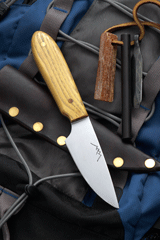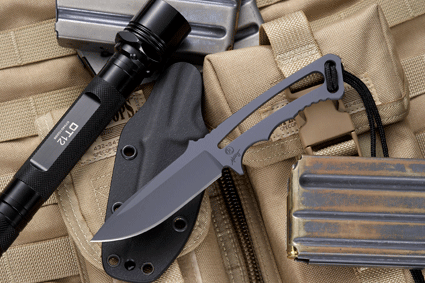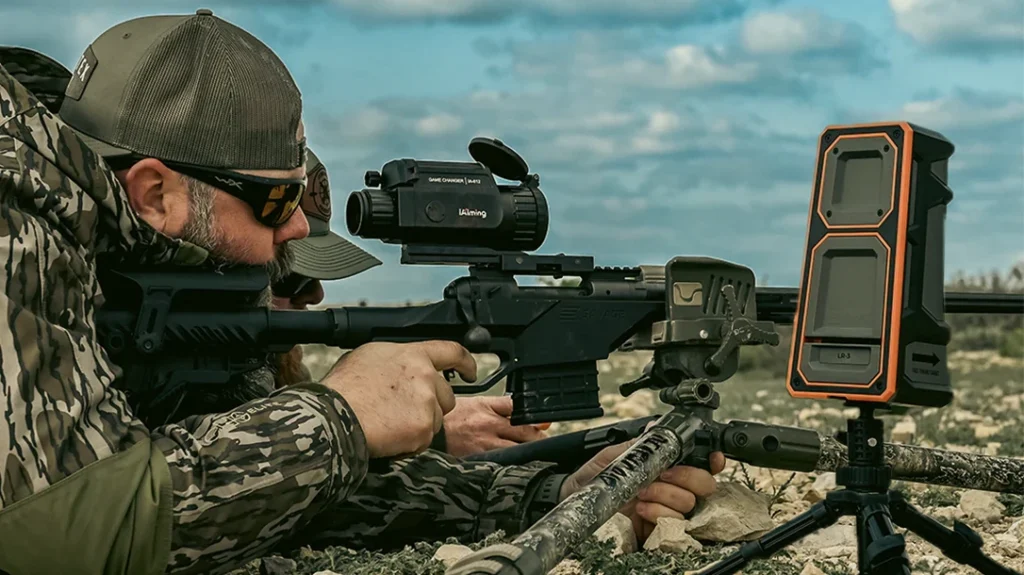When I think of a utility fixed blade, the knife style that first enters my mind is a neck knife. Neck knife designs are utilitarian by nature. This design, for the most part, is a great way to carry a strong, dependable fixed blade without the weight of a normal belt knife. Compact, yet tough, this is a common choice for the more experienced backpackers, kayakers, survivalists and other blade users who need to keep their load light.
 Background Logistics
Background Logistics
Bill Harsey and Chris Reeve also realized a well-designed neck knife had potential as a utility tool for those in the military. Both makers’ knives have a legacy that includes flawless craftsmanship and rugged design that has proven itself many times on the battlefield. The Chris Reeve Sebenza knife could be considered a Ferrari of the folder knife world. The “Professional Soldier” neck knife stemmed from the requests of combat troops wanting a dependable back-up blade that was compact, tactical, and useful in a variety of situations where a larger knife might not be as ideal. While talking to Chris on the phone, he reported that many soldiers, including Special Forces soldiers, normally keep their large blades in their packs when jumping. This knife can be strapped onto MOLLE gear and offers both a lightweight blade and a shackle wrench handy when the larger blade may not be at hand.
Pro Soldier Specs
The thickness of the Professional Soldier is 0.165 inch; hefty but not so much it feels like a crowbar around your neck. Should this be considered a neck knife? It depends on the user. I can wear it comfortably around my neck but I would say it is about the largest I would go with for this mode of carry. With an overall length of 7-3/8 inches, the knife is the perfect size to accompany larger knives and choppers. The blade is 3-1/2 inches long, coupled with a 4-inch handle, fulfilling the need of most practical chores that the soldier would need. It also comes coated with KG Gun-Kote to protect the knife and to give it a dull luster.
Advertisement — Continue Reading Below
Handle Dynamics
The skeletonized handle has a rounded-off tang on all sides except the very back butt end. Due to the thin nature of their handles, many neck knives can dig into the palm of your hand. The corners can also rub and even pinch on some models when torque is administered during chores like hard carving using the whole arm. The Professional Soldier’s rounded tang on the handle prevents this. Even the forward thumb ramp finger grooves are smooth. Two large, beveled lanyard holes are on the back of the knife near the end of the handle and the knife comes with an easily removable chord, said to muffle the sound when it is laid on a table. To me, it didn’t help that much; a piece of metal on a table makes a sound no matter how you lay it down!
To Paracord It, Or Not
It doesn’t take much to imagine this knife wrapped with paracord. Although it would look attractive with the wrap, and the two beveled holes would facilitate it nicely, one has to remember the sheath. If one were to paracord the knife, it would not fit into this particular sheath model, but you could easily get another sheath from a Kydex maker. I particularly like the skeletonized handle and the overall thin package of the knife. The company told me that it was designed to fit in the pocket of a soldier’s ACU’s. I found that it did this well and rode unnoticed in the pliers pocket of my Carhartts.
A Professional Sheath
The Kydex sheath is made by Blade-Tech, one of the more interesting companies of the industry, with many different sheath designs. While it seems to be a fad in the cutlery industry to put as much Kydex around a knife as possible, I enjoy the sleek and simple designs of this sheath. The rivet points are MOLLE compatible, with spacing for a Tek-Lock or even paracord if one wants the sheath tighter to the rig. The Kydex also features a hole for draining and cleaning. The sheath has two eyelets at the top to use as a neck rig.
Advertisement — Continue Reading Below
Magnesium Scraper
Though not my favorite fire starter, the magnesium block fire starters are a way to make a fire that everyone should become acquainted with. However, it can take forever to shave a pile of magnesium and can dull a knife fairly quickly. My attitude towards the magnesium fire starters changed slightly when I used the Professional Soldier. The pommel of the handle has a projection at the back that can be used for a glass breaker. However, unlike the rest of the knife, the butt of the handle has a 90-degree spine. I inquired about that and was told that it was one less spot to machine. I found I could use it to scrape the magnesium block. When positioning the block at an angle, I was able to produce shavings by pounding along the block in a long scraping motion. This produced a pile of magnesium shavings in a fraction of the time it normally takes to do so. At the end, I sealed the deal by producing sparks from the striker utilizing that same edge. It threw sparks on the ferro rod as well. This can be done while the knife is in the sheath, keeping lacerations to a minimum.
Multi-Use Cutaway
On Chris Reeve’s website, the knife is shown opening a D-shackle. I got to explore this feature using my jeep, which has shackles attached to the aftermarket bumper on the front. Despite the greasing and care I take to keep it dirt free, the mud and sand still lock up the shackles enough that hands alone sometimes can’t open them. In the sandy environment where our troops are deployed, this may happen pretty regularly, as Humvees have shackles on the front of the vehicles near the wheel wells.
Edge Retention
I was initially interested to see how the S30V would hold up. The hair-popping factory edge sliced paracord and large rope very well, while edge retention held fast throughout. I also cut military webbing, which can dull a knife as fast as cutting a seat belt. After a couple dozen webbing cuts, I ran out of the material and the knife was still shaving sharp. The Chris Reeve Professional Soldier has an HRC of 57-58, a good hardness compared to some other S30V knives, which can be a task to sharpen. The knife held up through a coffee can as well, with no nicks or edge chipping during the test.
Advertisement — Continue Reading Below
Soldier Endorsement
I interviewed an active duty first sergeant, veteran of several Airborne units, who also happens to be a cousin of mine, to see what he thought of the knife. He reported that it looked stout enough for the handle to pop off banding straps that they commonly encounter on ammo drops. It would also help during heavy load operations, where the C-17’s come in and drop MREs, Humvees and other equipment that the soldiers would need. The heavy drop parachutes and their contents are notorious for being a P.I.T.A to deal with; anything to alleviate that would be welcomed. Firefighters may find this knife handy as well, as the brush fire trucks are equipped with D-ring shackles, among other gadgets and nozzles, that an individual may find hard to open with gloved hands in a bulky suit.
The Chris Reeve Professional Soldier represents the efforts of a few quiet professionals’ requests, a product of feedback on what a soldier needs in the field. It stems from the folks at www.professionalsoldiers.com, and with their input the knife was formed and named after them. When the soldiers need it, Bill Harsey designs it and Chris Reeve machines it. What results is a knife that looks just as good as it functions, and will take it to the next level when one depends on it.
Check out Bill Harsey’s Combat Survival Knife – the Spartan Blades Difensa!
Advertisement — Continue Reading Below
























